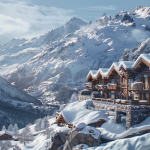Baklava, a decadent pastry hailing from the kitchens of the Ottoman Empire, has managed to capture the hearts of dessert connoisseurs worldwide. Its rich, sweet, and flaky layers offer an explosion of flavor that has been cherished for centuries. If you’ve ever wondered how to perfect the art of layering a traditional baklava with a delightful blend of nuts and honey, this article will guide you through the process. Let’s delve into this culinary journey where you’ll learn to master the phyllo dough, the nut filling, and the syrup to create a truly delightful dessert.
Understanding the Importance of Phyllo Dough in Baklava
The first step in crafting an outstanding baklava is getting to know your ingredients. At the heart of baklava is the phyllo dough, a paper-thin pastry that forms the flaky, layered base and top of the dessert. Pastry chefs spend years mastering the art of making this dough, but you can find pre-made sheets in the frozen aisle of most grocery stores.
Avez-vous vu cela : How to Prepare a Heartwarming Butternut Squash and Sage Risotto?
When working with phyllo dough, keep in mind that it can dry out quickly and become brittle. It’s advisable to keep your phyllo sheets under a slightly damp kitchen towel when not in use.
For a traditional baklava, you will need 16 layers of phyllo at the base, and another 16 at the top. Each layer needs to be brushed with melted butter before a new one is added. This not only adds a rich flavor but also helps the layers brown evenly and separate during baking.
A lire également : What’s the Key to Crafting a Luscious Passion Fruit and Coconut Panna Cotta?
Preparing the Nut Filling and Arranging the Layers
The heart and soul of baklava is its nut filling. This sweet and slightly crunchy element provides a delightful texture contrast to the flaky pastry layers. The choice of nuts varies, depending on regional and personal preferences. However, a blend of walnuts, pistachios, and almonds is a classic choice.
For a standard 9×13 inch pan of baklava, you will require about three cups of finely chopped nuts. To this, add half a cup of sugar and a generous sprinkle of ground cinnamon. The sugar and cinnamon not only sweeten the mix but also add a whole new flavor dimension complementing the nuts.
Once your nut mixture is ready, it’s time to start layering. Start with buttering the pan and laying down your first phyllo sheet. Remember to brush each sheet with butter as you stack them. After 16 layers of phyllo sheets and butter, evenly spread your nut mixture. Then, continue layering the remaining phyllo sheets, ensuring that each one is buttered.
Crafting the Perfect Sugar-Honey Syrup
The syrup is what makes baklava a delightfully sweet dessert. It seeps into the layers of the pastry and the nut filling, turning the baklava into a moist, sweet, and sticky dessert. In most recipes, the syrup is a blend of sugar, honey, and water, boiled until it reaches the right consistency.
For a pan of baklava, combine two cups of sugar with one cup of water in a saucepan over medium heat. Stir until the sugar dissolves, then add a cup of honey, and let the mixture simmer for about 20 minutes. The resulting syrup should be thick but still pourable.
Arguably, the most critical part of making baklava is when to apply the syrup. This should be done immediately after the baklava comes out of the oven. The contrast between the hot pastry and the cool syrup allows the syrup to seep into the layers effectively, ensuring that every bite is a sweet delight.
Baking and Serving Baklava
Once your baklava is layered and drenched in syrup, it’s time for it to bake. Preheat your oven to 350 degrees Fahrenheit (175 degrees Celsius) and let your baklava bake for about 50 minutes, or until the top is golden brown. Remember, each oven might have slightly different baking times, so keep an eye on your baklava to prevent it from burning.
Baklava is best served at room temperature. It’s a great dessert for dinner parties, as it can be made ahead of time and left to stand. Just remember to cut the baklava into squares or diamond shapes before baking, as trying to cut it after baking can cause the delicate phyllo layers to shatter.
Mastering baklava is a rewarding culinary adventure. Its intricate layers of buttery phyllo pastry, sweet nutty filling, and sticky honey syrup all combine to create a dessert that impresses both visually and gastronomically. So, don’t shy away from the challenge, and soon enough, you’ll be able to perfect the art of layering a traditional baklava with nuts and honey.
Tips for Achieving the Perfect Baklava Recipe
As you embark on your journey to create the perfect baklava recipe, it’s crucial to remember a few tips that can make or break your dish. First off, make sure your food processor is sharp enough to chop your nuts finely without turning them into a paste. It’s the texture of the finely chopped nuts that give the baklava its distinctive crunch.
Another important aspect of the process is the buttering of the phyllo sheets. Ensure to use unsalted melted butter to not overwhelm the sweet flavor of the baklava. The butter also aids in creating those crisp, golden layers. Brush each sheet evenly, and remember the rule of 16 layers before and after the nut mixture.
When preparing the honey syrup, consider adding a dash of lemon juice. The citrusy tang of lemon can cut through the sweetness of the syrup and provide a balanced flavor. Be sure to add the syrup to the hot baklava, straight out of the oven, because it is at this point that the pastry best absorbs the syrup.
Lastly, let the baklava sit at room temperature for several hours, or even overnight, before serving. This resting time allows the syrup to further penetrate the layers and enhance the flavor.
Conclusion: Mastering Your Own Greek Baklava
Mastering the art of layering a traditional baklava with nuts and honey can seem like an intimidating task. However, with a careful understanding of the phyllo dough, the nut mixture, and the honey syrup, the process becomes more manageable and enjoyable.
The key to a successful Greek baklava lies in the details. From the exact measurement of ingredients to the number of phyllo sheets in the layers, every element in the recipe contributes to the final outcome. The way you handle the phyllo dough, how you prepare the nut mixture, the making of the syrup, and even the baking process – each step is a building block in achieving the perfect baklava.
As you practice more, you’ll find your rhythm in handling the delicate phyllo pastry, and you’ll learn the right consistency for your syrup. You’ll know when your baklava is perfectly baked just by its color and aroma. Whether you’re serving it at a dinner party or enjoying it on a quiet afternoon, the satisfaction of creating a delicious baklava is second to none.
So, don your apron, gather your ingredients, and embark on this exciting journey. With patience, practice, and an appreciation for this centuries-old dessert, you’ll soon perfect the art of making a traditional baklava with nuts and honey.











